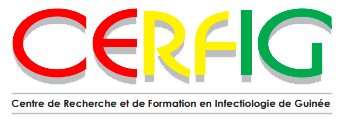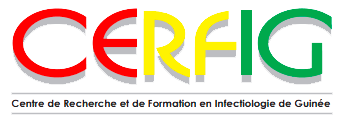
Lanceï KABA
Post-doctorant en Modélisation
- Email
-
Fonction :WAMCAD
-
Formation :DVM, M.Sc, PhD en Epidémiologie
Biographie
Vétérinaire épidémiologiste, Enseignant-chercheur à l’ISSMV de Dalaba, diplômé de l’Institut Supérieur des Sciences et de Médecine Vétérinaire (ISSMV) de Dalaba en formation initiale, a ensuite passé son master 2 à l’Ecole Nationale Vétérinaire d’Alfort (ENVA) de Paris en 2013, et puis, a terminé par un doctorat en épidémiologie des maladies infectieuses à l’Institut Hospitalo-Universitaire (IHU) Méditerranée Infection, d’Aix-Marseille Université en 2022. Actuellement post-doctorant en modélisation du paludisme et des maladies tropicales négligées au Centre de recherche et de formation en infectiologie de Guinée (CERFIG). Il travaille sur des études épidémiologiques et l’analyse biostatistique des données de recherche.
Formations
- Post-doctorat
Formations
- Resistance profile of urine isolate enterobacteral strains at Donka University teaching hospital in Conakry, Guinea; Article; Apr 2024;
Djiba Kaba, Ousmane Niabaly, Issagha Diallo, Mohamed Cisse; The objective of this study was to describe the resistance profile of enterobacterals isolated from urine samples at the laboratory of Donka National Hospital. Urine samples were collected from both outpatients and hospitalized patients. Cultures were performed using standard techniques, strains were identified using the API 20E kit, and antibiotic…;
-
Comparative evolutionary analyses of peste des petits ruminants virus genetic lineages; Article; Mar 2024; Maxme courcelle; Habib Salami; Kadidia Tounkara; Arnaud Bataille; Peste des petits ruminants virus (PPRV) causes a highly infectious disease affecting mainly goats and sheep in large parts of Africa, Asia, and the Middle East and has an important impact on the global economy and food security. Full genome sequencing of PPRV strains has proved to be critical to increasing our understanding of PPR epidemiology and…
-
Seroprevalence and Risk Factors of Toxoplasmosis in Cats and Women Undergoing Prenatal Consultation in Coyah, Guinea; Article; Yacouba KONATE; Pé GOUMOU; Lanan Wassy Soromou; Youssouf SIDIME; The objective of this study is to describe the epidemiological situation of toxoplasmosis in cats and women undergoing prenatal consultation in the city of Coyah (Guinea). During the study, 100 cat sera and 100 sera from women in prenatal consultation were analyzed with a Toxo-Screen DA (Modified Antigen Agglutination Test) kit. The results indicat…
-
Определение уровня иммунной прослойки сельскохозяйственных животных к возбудителям зоонозных инфекционных болезней в Гвинейской Республике (Identification of the Farm Animals Immune to Pathogens of Zoonotic Infectious Diseases in the Republic of Guinea); Article; Jul 2022; Еkaterina V. Naidenova; Mikhail Kartashov; А П Шевцова; В В Кутырев; The most common anthropozoonoses on the African continent are coxiellosis and Rift Valley fever. It is known that detection of specific IgG antibodies in the blood sera of farm animals is one of the indicators of the pathogen circulation in a certain territory. The aim of the work was to identify specific IgG antibodies in the blood sera of farm an.
-
Dynamics of Variants of Concern (VOC) of SARS-CoV-2 during the Different Waves of COVID-19 in Senegal; Article; May 2022; Abdou Padane; Cyrille K Diedhiou; Khadim Gueye; Souleymane Mboup; Background: In Senegal, the incidence of SARS-CoV-2 evolved with four successive epidemic waves. The first wave started in March 2020 with low virus variability, whilst the second outbreak, which started in December 2020, was dominated by the Alpha variant. The third wave took place in June 2021, and the fourth at the end of November 2021. Our inte…
-
A Non-Invasive Neonatal Signature Predicts Later Development of Atopic Diseases; Article; Youssouf Sereme; Moïse Michel; Soraya Mezouar; Joana Vitte; Background: Preterm birth is a major cause of morbidity and mortality in infants and children. Non-invasive methods for screening the neonatal immune status are lacking. Archaea, a prokaryotic life domain, comprise methanogenic species that are part of the neonatal human micro-biota and contribute to early immune imprinting. However, they have not…
-
Control of common viral epidemics but not of SARS-CoV-2 through the application of hygiene and distancing measures; Article; Apr 2022; Audrey Giraud-Gatineau; Lanceï Kaba; Céline Boschi; Didier Raoult; We systematically survey respiratory and gastrointestinal infections of viral origin in samples sent to our university hospital institute in Marseille, southern France. Here, we evaluated whether the measures implemented to fight COVID-19 had an effect on the dynamics of viral respiratory or gastrointestinal infections. Methods We analy…
-
A Non-Invasive Neonatal Signature Predicts Later Develop- ment of Atopic Diseases; Preprint; Mar 2022; Youssouf Sereme; Moïse Michel; Soraya Mezouar; Joana Vitte; Preterm birth is a major cause of morbidity and mortality in infants and children. Non-invasive methods for screening the neonatal immune status are lacking. Archaea, a prokaryotic life domain, comprise methanogenic species that are part of the neonatal human microbiota and contribute to early immune imprinting. However, they have not y…
-
Consequences of the COVID-19 Outbreak Lockdown on Non-Viral Infectious Agents as Reported by a Laboratory-Based Surveillance System at the IHU Méditerranée Infection, Marseille, France; Article; Lanceï Kaba; Audrey Giraud-Gatineau; Marie-Thérèse Jimeno; Hervé Chaudet; The objective of this paper is to describe the surveillance system MIDaS and to show how this system has been used for evaluating the consequences of the French COVID-19 lockdown on the bacterial mix of AP-HM and the antibiotic resistance. MIDas is a kind of surveillance activity hub, allowing the automatic construction of surveillance control boar…
-
Combining viral genetic and animal mobility network data to unravel peste des petits ruminants transmission dynamics in West Africa. Article; Mar 2021; Arnaud Bataille; Habib Salami; Ismaila Seck; Andrea Apolloni; Peste des petits ruminants (PPR) is a deadly viral disease that mainly affects small domestic ruminants. This disease threaten global food security and rural economy but its control is complicated notably because of extensive, poorly monitored animal movements in infected regions. Here we combined the largest PPR virus genetic and animal mobility n…
-
Regional evolutionary dynamics of peste des petits ruminants virus in West Africa: influence of livestock trade; Conference Paper; Sep 2016; Arnaud Bataille; Caroline Coste; Habib Salami; Geneviève Libeau; Peste des petits ruminants (PPR) is a highly contagious and devastating viral disease of small ruminants. It represents a serious risk for the economy and food security in regions of Africa, Middle East and Asia where the disease is endemic. Integrated knowledge of evolutionary and epidemiological factors underlying PPR virus (PPRV) emergence, pers…
-
CZU: 576.895.772(6) IDENTIFICATION OF TRYPANOSOMES IN TSETSE FLIES IN SAMAYA AND DAMAKANYA, WESTERN GUINEA; Article; Jan 2015; Seydou Sylla; Youssouf Sidimé; Valentina Petcu; Saran Camara; Trypanosomes are parasitic protozoans that live in the blood of a great variety of species including human transmitted by the tsetse flies. Indentifying trypanosomes in tsetse flies provides a measure of disease risk and a basis for the design of control approaches. The objective of the present study was to identify the species of the trypanosomes…

